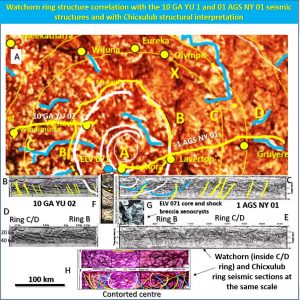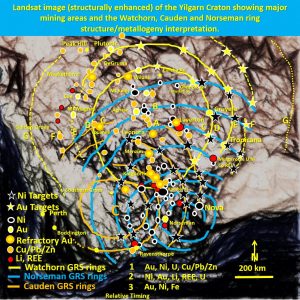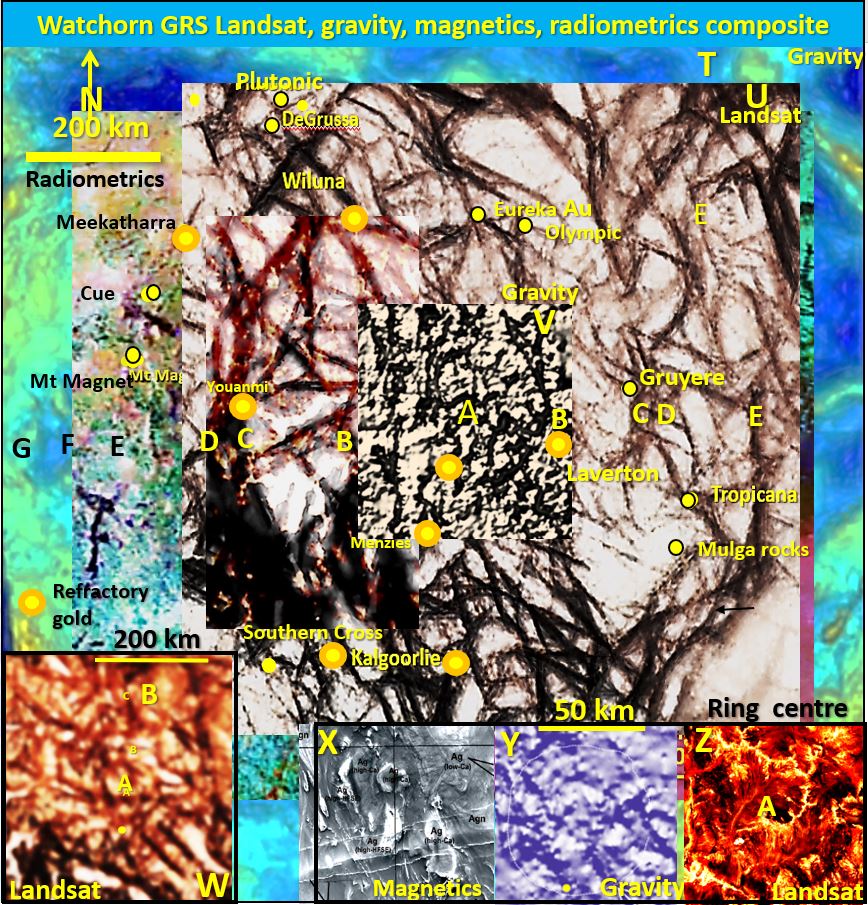The 700 km diameter Watchorn Probable Impact Structure, prima facies evidence in ELV 071 core, relationship to mineralisation, Landsat, Radiometrics, Gravity and Seismic research 1999 – 2018.
The following evidence suggests Watchorn probable impact structure is an impact structure. The morphometric dimensions of an impact structure of 700 km maximum diameter are observed in Landsat, topographic, gravity, radiometric and seismic data. Prima facies evidence of impact is seen in ELV 071 core which is located on the strong Leonora inner ring.
This paper is the culmination of nearly 50 years research of the Yilgarn by the author. It will change the fundamental way in which the geology of the Yilgarn is viewed and explored.

The paper has many figures as a picture tells a thousand words and the giant ring structure is more easily shown in an image than described.
Sequence and results of Watchorn probable impact structure research.
Watchorn probable impact structure was discovered in 1999 using horizontal derivative gravity data. It was 250 km in diameter and had the morphometric dimensions of an impact structure. The ring dimension of 500 km diameter was observed in Landsat in 2003. From 2013 – 2017 field studies were carried out to determine whether there were any shocked rocks as a result of an impact that may have caused the Watchorn giant ring structure. Strongly strained rocks that had a similar morphology to shattercones (termed shatterrods) were found on the Darlot ring, Agnew ring, Mt Keith ring, Honeymoon Well ring, Leonora ring and at Laverton on the Agnew ring.
Research in 2018 discovered a strong, wide ring (Wiluna ring) on Landsat, palaeochannels and gravity. This ring extends from Wiluna, through Gruyere, Kalgoorlie, Youanmi and back to Wiluna, and has a diameter of 500 km and a 30 km width. It is suggested that it represents the extended rim of an impact crater which if proved is the largest on Earth. The Meekatharra ring of 700 km diameter is observed on Landsat, Palaeochannels, radiometrics and gravity. It passes through Meekatharra, Plutonic. Tropicana, south of Kambalda, Southern Cross, Mt Magnet and Cue.
New insights have been gained into the underlying structure of the Yilgarn. It has been observed in the Landsat and other geological and geographical data that the near surface NNW and NS greenstone belts do not appear to have a fundamental role in the structural fabric of the Yilgarn. This fabric is formed by earlier, underlying deep-seated structures. Watchorn, and the other reported GRSs, ring pattern appears to have influenced the pattern and boundaries of the of the Yilgarn surface structures. The Watchorn ring structures often form the boundaries between areas of large age difference that suggests uplift and down-warping.
The Permian palaeochannel system is not affected by the NNW structural trend of the surface of the Yilgarn but by these underlying ring structures. It correlates with the ring patterns of the various giant ring structures more than the NNW and NS surface structures. The Permian glacial event eroded out the fractured geology around the inside of the GRS rings, as it did at Shoemaker impact crater north of Wiluna. This palaeochannel pattern has the morphometric dimensions of a 500 km diameter impact structure with the centre at Leonora ring A, the central uplift extending to Agnew ring B, the outer ring at Wiluna ring C/D and the extended ring on the 700km Meekatharra ring.
Seismic sections Leonora-Gruyere 01 AGS NY 01 and Leinster – Windimurra 10 GA YU 01 were studied to define the third dimension of the ring structures. Steep structures, bowl structures and circular structures were closely associated with the ring structures. The strongest steep structures correlate with Agnew ring B, Wiluna C/D ring, and Meekatharra E ring. These are also the strongest rings in Landsat, radiometrics and gravity. There are vertical ring and bowl structures associated with the centre of the giant ring structure and they also formed inside the major rings. The Landsat, radiometric, gravity and palaeochannel morphometric dimensions and the correlating steep, arcuate, circular and saucer seismic structures correlate well with those at Chicxulub impact structure in Mexico.
Prima facies evidence of impact rocks is needed to confirm an impact origin. Detailed structural lithological logging of ELV 071 core in 2017 combined with the geophysical data provided evidence that the core is an Archaean breccia pipe. The intrusion picked up xenoliths that have come from a buried, impact shock-deformed source rock with a mid to upper crust provenance. This was the conclusion of Hamilton, Wright and Bewick who originally logged the core in 2009. This is at variance with the 2016 conclusion by Glikson, Hickman and Crossley that the ELV 071 core is a post-Permian, unconsolidated impact shock metamorphic breccia deposited in a late 11 km diameter crater.
This is unambiguously an Archaean impact breccia intruded up in a pipe. If in doubt the core is available at the Kalgoorlie core library to be logged. The only documented local source for this breccia is the Watchorn giant ring structure. Drill hole ELV 071 is located on the Leonora ring which has been defined by Landsat, magnetics, gravity, radiometrics and topography. Watchorn giant ring structure is 700 km in diameter out to the Meekatharra ring and is thus powerful enough to produce this shock deformation quartz and granite 50 km from the centre.
The above evidence of; concentric rings, prima facies evidence shocked rocks and the continuing uplift of the central ring area strongly suggest an impact origin for Watchorn GRS.
The ring structures have been studied to determine their relationship to the geology of the gold and nickel mines. Research from 1999 to 2018 has showed that the largest gold, nickel, copper, silver-lead-zinc and rare earth mines in the Yilgarn have a strong spatial, and perhaps genetic, correlation with these rings. This suggests that the rings are important for the genesis of mineralisation and thus for exploration targeting. The mineralisation in the Yilgarn correlates closely with the surface expression of the rings because the steep arcs and subvertical radiating fault structures observed on the seismic sections, and associated with the ring structures, are the only mantle tapping structures. These surface to mantle structures act as fluid pathways. They focus the mineralisation and the major gold and nickel mines lie above these structures on antiform structures. Gold mining fields in the Yilgarn are associated with antiformal (domal) structures. It is suggested that these antiformal structures form a series of domal structures, observed in the Southern Cross and Mt Pleasant/Kalgoorlie/Kambalda areas, that extend right around the ring perimeters and define exploration targets in favourable structural/lithological intersection areas.
The largest gold mines are located on, or very close to the Watchorn rings and the giant deposits are located on the intersection of multiple giant ring structures. The largest nickel deposits are on the eastern arcs of the GRSs. The location of the Nickel deposits may be because the hot spot magma nickel source (plume?) preferentially intrude the ~NS section of the rings because they are perpendicular (NS) to the EW hot spot travel direction. For gold and nickel targeting in the Archaean areas of the Yilgarn the intersection of multiple GRS and the intersection of rings with favourable stratigraphy are the most important locii. Greenstone belts do not appear to have a role in the underlying structural framework of the Yilgarn but they are important locally for mineralisation because they are at the current surface and are good host rocks as they have ideal competency and chemical characteristics.
For targeting in the overlying younger geological areas the same criteria as for the Archaean is used. The targets are the concentration of underlying Archaean mineralisation in favourable structural areas in the younger rocks (for example Tropicana (Au) and Mulga Rocks (U, Ni, Co, REE). The covered area to the north of Gruyere and Tropicana, around to Plutonic, is prospective for these remobilised deposits.

| aa YW #5 Watchorn correlation of ELV 071 TMI Landsat gravity seismic.pdf | 4 MB |

